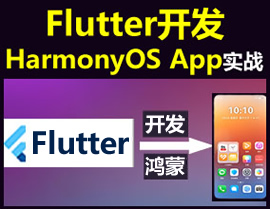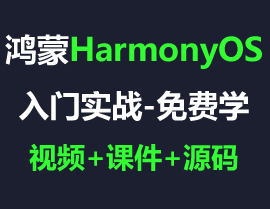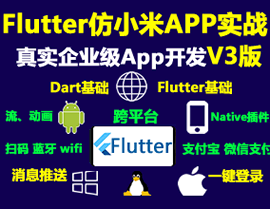Flutter通道通信插件easy_channel的使用
Flutter通道通信插件easy_channel的使用
easy_channel
easy_channel 是一个用于在 Flutter 中实现通道通信的新插件项目。
功能概述
easy_channel 插件允许开发者通过平台通道(Platform Channels)在 Flutter 和原生代码之间进行高效的数据通信。它简化了通道通信的复杂性,提供了简单易用的接口。
使用步骤
以下是一个完整的示例,展示如何在 Flutter 应用中使用 easy_channel 插件。
1. 添加依赖
在项目的 pubspec.yaml 文件中添加 easy_channel 作为依赖:
dependencies:
easy_channel: ^1.0.0 # 替换为最新版本号运行 flutter pub get 下载并安装依赖。
2. 创建一个简单的 Flutter 示例
示例代码
以下代码展示了如何在 Flutter 端发送数据并通过 easy_channel 插件与原生代码通信。
// example/lib/main.dart
import 'package:flutter/material.dart';
import 'package:easy_channel/easy_channel.dart'; // 引入 easy_channel 插件
void main() {
runApp(const MyApp()); // 启动应用
}
class MyApp extends StatefulWidget {
const MyApp({Key? key}) : super(key: key);
@override
State<MyApp> createState() => _MyAppState(); // 初始化状态
}
class _MyAppState extends State<MyApp> {
String _platformVersion = 'Unknown'; // 平台版本信息
final _easyChannelPlugin = EasyChannel(); // 创建 EasyChannel 实例
@override
void initState() {
super.initState();
// 在初始化时向原生代码发送消息
_easyChannelPlugin.post('nav.call.request', {'sasa': 'asas'});
}
@override
Widget build(BuildContext context) {
return MaterialApp(
home: Scaffold(
appBar: AppBar(
title: const Text('Easy Channel 示例'), // 设置标题
),
body: Center(
child: Text('运行在: $_platformVersion\n'), // 显示平台版本
),
),
);
}
}3. 原生端处理
为了使 easy_channel 能够正常工作,需要在原生代码中注册对应的通道处理器。
Android 原生代码示例
在 MainActivity.java 中注册通道处理器:
// android/app/src/main/java/com/example/easy_channel_example/MainActivity.java
package com.example.easy_channel_example;
import android.os.Bundle;
import io.flutter.embedding.android.FlutterActivity;
import io.flutter.plugin.common.MethodCall;
import io.flutter.plugin.common.MethodChannel;
import io.flutter.plugins.GeneratedPluginRegistrant;
public class MainActivity extends FlutterActivity {
private static final String CHANNEL = "nav.call.request"; // 定义通道名称
@Override
protected void onCreate(Bundle savedInstanceState) {
super.onCreate(savedInstanceState);
GeneratedPluginRegistrant.registerWith(this);
// 注册通道处理器
new MethodChannel(getFlutterEngine().getDartExecutor().getBinaryMessenger(), CHANNEL)
.setMethodCallHandler((call, result) -> {
if (call.method.equals("nav.call.request")) {
// 处理接收到的消息
System.out.println("接收到的消息: " + call.arguments.toString());
result.success("请求成功");
} else {
result.notImplemented();
}
});
}
}iOS 原生代码示例
在 AppDelegate.m 中注册通道处理器:
// ios/Runner/AppDelegate.m
#import "AppDelegate.h"
#import <Flutter/Flutter.h>
[@implementation](/user/implementation) AppDelegate
- (BOOL)application:(UIApplication *)application
didFinishLaunchingWithOptions:(NSDictionary *)launchOptions {
[GeneratedPluginRegistrant registerWithRegistry:self];
// 注册通道处理器
FlutterViewController *controller = (FlutterViewController *)self.window.rootViewController;
FlutterMethodChannel *channel =
[FlutterMethodChannel methodChannelWithName:@"nav.call.request"
binaryMessenger:controller.binaryMessenger];
[channel setMethodCallHandler:^(FlutterMethodCall *call, FlutterResult result) {
if ([@"nav.call.request" isEqualToString:call.method]) {
NSLog(@"接收到的消息: %@", call.arguments);
result(@"请求成功");
} else {
result(FlutterMethodNotImplemented);
}
}];
return YES;
}
[@end](/user/end)更多关于Flutter通道通信插件easy_channel的使用的实战系列教程也可以访问 https://www.itying.com/category-92-b0.html
easy_channel 是一个用于简化 Flutter 与原生平台(Android 和 iOS)之间通信的插件。它提供了一种简单的方式来在 Flutter 和原生代码之间传递消息,而不需要手动编写大量的平台通道代码。
安装 easy_channel
首先,你需要在 pubspec.yaml 文件中添加 easy_channel 依赖:
dependencies:
flutter:
sdk: flutter
easy_channel: ^1.0.0然后运行 flutter pub get 来安装插件。
基本用法
1. 在 Flutter 中发送消息到原生平台
在 Flutter 中,你可以使用 EasyChannel 来发送消息到原生平台:
import 'package:easy_channel/easy_channel.dart';
void sendMessageToNative() async {
String channelName = 'com.example.myapp/channel';
String methodName = 'getDeviceInfo';
var result = await EasyChannel.send(channelName, methodName, {'key': 'value'});
print('Received from native: $result');
}2. 在原生平台中接收消息
在 Android 和 iOS 平台上,你需要设置一个接收器来处理来自 Flutter 的消息。
Android (Kotlin):
在 MainActivity.kt 中:
import io.flutter.embedding.android.FlutterActivity
import io.flutter.embedding.engine.FlutterEngine
import io.flutter.plugin.common.MethodChannel
class MainActivity: FlutterActivity() {
private val CHANNEL = "com.example.myapp/channel"
override fun configureFlutterEngine(flutterEngine: FlutterEngine) {
super.configureFlutterEngine(flutterEngine)
MethodChannel(flutterEngine.dartExecutor.binaryMessenger, CHANNEL).setMethodCallHandler { call, result ->
if (call.method == "getDeviceInfo") {
val deviceInfo = getDeviceInfo()
result.success(deviceInfo)
} else {
result.notImplemented()
}
}
}
private fun getDeviceInfo(): Map<String, String> {
return mapOf("model" to android.os.Build.MODEL, "manufacturer" to android.os.Build.MANUFACTURER)
}
}iOS (Swift):
在 AppDelegate.swift 中:
import UIKit
import Flutter
@UIApplicationMain
@objc class AppDelegate: FlutterAppDelegate {
override func application(
_ application: UIApplication,
didFinishLaunchingWithOptions launchOptions: [UIApplication.LaunchOptionsKey: Any]?
) -> Bool {
let controller : FlutterViewController = window?.rootViewController as! FlutterViewController
let channel = FlutterMethodChannel(name: "com.example.myapp/channel",
binaryMessenger: controller.binaryMessenger)
channel.setMethodCallHandler({
(call: FlutterMethodCall, result: @escaping FlutterResult) -> Void in
if call.method == "getDeviceInfo" {
let deviceInfo = self.getDeviceInfo()
result(deviceInfo)
} else {
result(FlutterMethodNotImplemented)
}
})
GeneratedPluginRegistrant.register(with: self)
return super.application(application, didFinishLaunchingWithOptions: launchOptions)
}
private func getDeviceInfo() -> [String: String] {
return ["model": UIDevice.current.model, "systemVersion": UIDevice.current.systemVersion]
}
}3. 在原生平台中发送消息到 Flutter
你也可以从原生平台发送消息到 Flutter。
Android (Kotlin):
MethodChannel(flutterEngine.dartExecutor.binaryMessenger, CHANNEL).invokeMethod("updateStatus", mapOf("status" to "connected"))iOS (Swift):
channel.invokeMethod("updateStatus", arguments: ["status": "connected"])在 Flutter 中接收消息:
EasyChannel.receive('com.example.myapp/channel', (method, arguments) {
if (method == 'updateStatus') {
print('Status updated: ${arguments['status']}');
}
});






